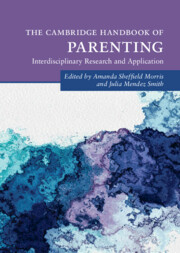Book contents
- The Cambridge Handbook of Parenting
- Cambridge Handbooks in Psychology
- The Cambridge Handbook of Parenting
- Copyright page
- Dedication
- Contents
- Contributors
- Figures
- Tables
- Introduction
- Part I Foundations of Parenting
- Part II Parenting across Development: Social, Emotional, and Cognitive Influences
- Part III Parental Factors That Impact Parenting
- Part IV Child Factors that Impact Parenting
- Part V Parent Education, Intervention and Policy
- 22 Parent and Family Engagement in Early Education Programs
- 23 Refugee Policies and Parenting in the United States and Germany
- 24 Parents as Earners: What Parental Work Means for Parenting and the Role of Public Policy
- 25 Parenting of Children Involved in the Child Welfare System
- 26 Technology and Parenting: Challenges and Opportunities
- 27 Preventing Risk Behaviors in Adolescence
- Index
- References
25 - Parenting of Children Involved in the Child Welfare System
from Part V - Parent Education, Intervention and Policy
Published online by Cambridge University Press: 01 December 2022
- The Cambridge Handbook of Parenting
- Cambridge Handbooks in Psychology
- The Cambridge Handbook of Parenting
- Copyright page
- Dedication
- Contents
- Contributors
- Figures
- Tables
- Introduction
- Part I Foundations of Parenting
- Part II Parenting across Development: Social, Emotional, and Cognitive Influences
- Part III Parental Factors That Impact Parenting
- Part IV Child Factors that Impact Parenting
- Part V Parent Education, Intervention and Policy
- 22 Parent and Family Engagement in Early Education Programs
- 23 Refugee Policies and Parenting in the United States and Germany
- 24 Parents as Earners: What Parental Work Means for Parenting and the Role of Public Policy
- 25 Parenting of Children Involved in the Child Welfare System
- 26 Technology and Parenting: Challenges and Opportunities
- 27 Preventing Risk Behaviors in Adolescence
- Index
- References
Summary
The child welfare system is primarily designed to serve children who have been maltreated, a form of parenting that is arguably the most deleterious that children can experience. The latest national data indicate that there were 618,000 children in the U.S. Who were maltreated in 2020, at a rate of 8.4 per thousand children (Administration for Children and Families, 2020). Beyond being direct victims of child abuse and neglect, they may experience a multitude of environmental risks, including poverty, parental mental illness, parental substance use, and family and community violence (Hecht & Hansen, 2001; McKenzie et al., 2011). These contextual risks lead to a variety of adverse outcomes for maltreated children that span developmental domains (Jonson-Reid et al., 2012; Jones Harden et al., 2016; Toth & Manly, 2019). The features of the parenting that maltreated children experience may exacerbate or compensate for these contextual risks, and influence their short- and long-term developmental trajectories.
- Type
- Chapter
- Information
- The Cambridge Handbook of Parenting , pp. 560 - 591Publisher: Cambridge University PressPrint publication year: 2022



